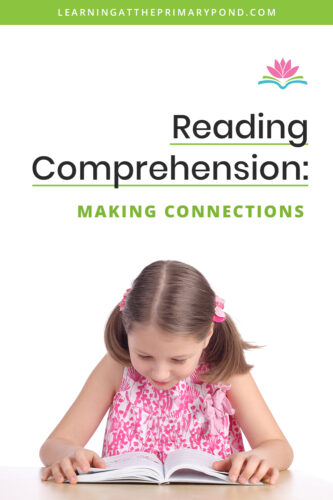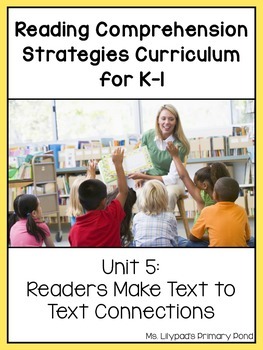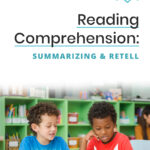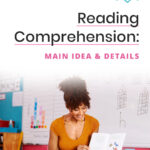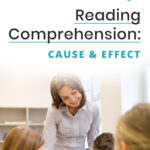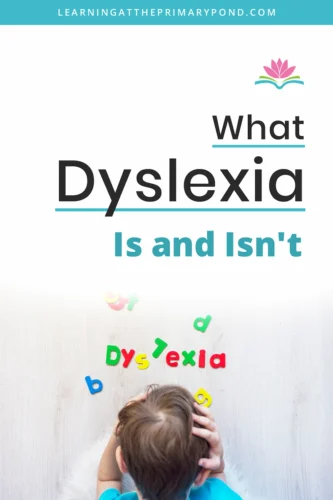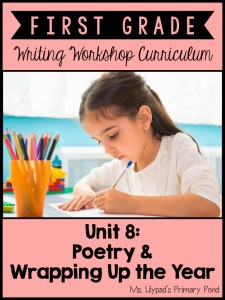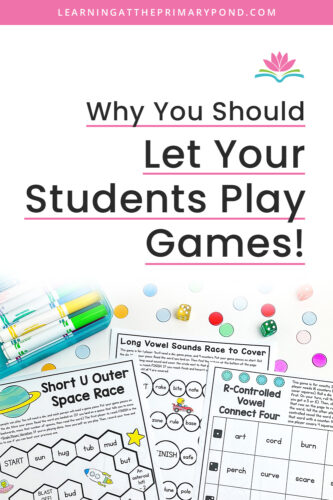Teaching students to make connections when reading is valuable for multiple reasons! Not only does it increase student engagement, but it also helps support retention and comprehension.
In this post, I’ll explain three types of connections that we can teach our students to make. I’ll also provide examples of how I’d teach and prompt for each type of connection!
**This post is part of a series on reading comprehension, so if you haven’t had a chance to check out the other posts, here they are:
Reading Comprehension: Summarizing & Retell
Reading Comprehension: Main Idea & Details
Reading Comprehension: Cause & Effect
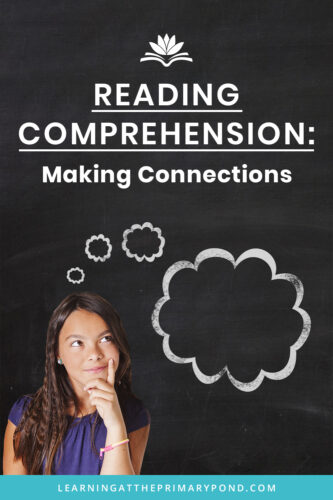
What Are the 3 Types of Connections?
There are three different types of connections, and some connections are easier for students to make than others.
1. Text-to-Self: If you’ve ever been in the middle of a read-aloud and a student interrupts (“I like pizza, too!”) after hearing something you’ve read, they were most likely actually making a text-to-self connection! A text-to-self connection is one where students are reminded of personal experiences when reading a book or passage. An event, character, or feeling in the book prompted the student to recall something similar in their own lives.
- For example: while reading a book about animals, a student says, “I saw a giraffe this weekend when I went to the zoo.”
The text-to-self connection is usually the easiest to teach and utilize because it’s something that students tend to do naturally.
As students become more proficient with text-to-self connections, we want to encourage them to go deeper: “How does making this connection help you better understand the text?”
2. Text-to-Text: Exactly as it sounds, this is when students make connections between two different texts. They might notice similarities between the topics, author/illustrator, similar events in the plot, and/or characters.
- For example: while reading a poem about falling leaves, a student says, “This makes me think of the book we read about the changing seasons.”
Purposefully choosing texts where students can easily make text-to-text connections helps facilitate development of this skill.
3. Text-to-World: For this type of connection, students are thinking of real events or social issues as they are reading a text. Students might have learned about these topics from technology (i.e. TV or computers) or from hearing other people’s discussions.
- For example: while reading a story about a family struggling to make ends meet, a student says, “On the news this morning, I also saw a family who was needing some things. They were asking for donations because the family had a fire.”
This is presumably going to be the most difficult type of connection for students to make, especially considering their age and level of exposure to history, current events, etc.
You can make it easier for students to practice text-to-world connections by providing background knowledge via a news clip or article.
How Can You Teach Making Connections?
Making connections as described above comes naturally to some students, but for others, explicitly teaching and reviewing will be key.
Here are a few tips and activities:
- As with so many literacy skills, the first step is to model the skill for your students! As you’re reading, say aloud the genuine connections you make – “As I was just reading that, it made me think about when I went to Arizona and saw a mountain for the first time. I remember there was a little bit of snow at the top, which helps me understand that it may get colder as you go up a mountain.” It’s important to also name what you’re doing – “I just made a text-to-self connection.”
- If you’re looking for specific lesson plans to help teach text-to-text connections, check out Unit 5 of my Reading Comprehension Lesson Plans for Kindergarten and First Grade!
- Something I’ve seen done really successfully in classrooms is to teach students a non-verbal cue for when they’ve made some sort of connection. That way, they can be making connections as you’re doing a read-aloud, but not interrupt. In fact, once I was in a preschool classroom with 3 year olds, and the teacher taught them to do the shaka sign (thumb and pinky out, other fingers in a loose fist) every time a book made them think of something from their own lives. It was amazing to see students this young making text-to-self connections! Having the non-verbal cue was key because students could freely do this without interrupting the lesson.
- Put up anchor charts around the room that remind students of the different types of connections, and include examples of each. Having this visual is a great reminder!
- As students are reading independently, you can encourage them to use sticky notes in books to make note of their connections. You could even write back to the student to acknowledge the connection they made.
- During your read aloud, shared reading, or small group instruction, provide opportunities for students to share their own connections. Having them work with partners is a way to save a bit of time but also ensure everyone has a chance to share. Students can always write down their connections later, too.
What Can You Do If Students Are Struggling to Make Connections?
If students are not making connections on their own, prompting can help. Here are some prompts I’d use in either a whole group or small group setting:
For text-to-self:
- Has anything like that ever happened to you?
- Tell me about a time when you _____. How is that similar to what happened in this text?
For text-to-text:
- Does this remind you of another book you’ve read before?
- What is similar between _____ and _____? (comparing Text A to Text B)
For text-to-world:
- Does this remind you of anything you’ve seen or heard about in the world?
- We learned about _____ (insert real life event/topic). How does this text relate to that?
Conclusion
When thinking about making connections, we also want to consider the range of depth of each connection.
Some connections are more surface level (i.e. “My neighbor has a red car like the one in the book!”) while others hit at a deeper level (“When the boy in the book felt left out, it reminded me of a time when I was really sad because I didn’t have anyone to play with at recess.”)
Help push students to make those deeper connections when applicable.
If you’re in need of student-led, highly-effective strategies (that require NO PREP!) to teach reading comprehension, here’s another blog I wrote on that very topic: 2 High-Impact Reading Comprehension Activities that Require No Prep Whatsoever!
Happy teaching!
